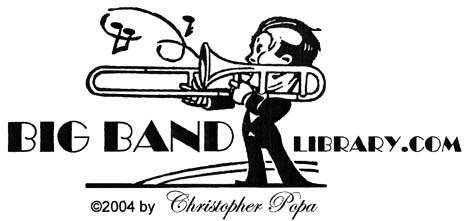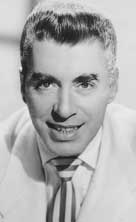
He grew up in the Detroit area and played the tenor saxophone. When he first organized a band, they performed at proms and debuts around the Midwest.
vital stats:
given name Arthur Joseph Mooney
birth Feb. 11, 1911, Lowell, MA
death Sept. 9, 1993, lung disease
sister Marce Kaminsky
wife Vera
military service U.S. Army Air Corps, 1942-1945?
A few years after World War II ended, Mooney hit gold with novelties and unusual sounds in his music, like the use of a glockenspiel, a banjo, and group singing.
He broke into the "big apple," New York City, with a two-week job, thanks to Maria Kramer, owner of the Lincoln and Edison hotels there. The public loved his music, and two weeks stretched into eight months!
He then played the nearby Capitol and Strand theaters, and, later, in various theaters and ballrooms across the country, including eight weeks at the Palladium in Hollywood.
Besides his three gold records, other songs in his repertoire included, for example,
Honey-Babe, I've Been Working On the Railroad, Donkey Got Drunk, Hop-Scotch Polka (Scotch Hot), Hey, Mr. Banjo, There's Something About a Hometown Band, Doo De Doo On An Old Kazoo, and Toot, Toot, Tootsie!.
He began recording for MGM in 1947, and they released a steady stream of his discs on 78 and, within a few years, 45 rpm.
His new recordings included the long-play (LP) albums "The Happy Minstrels" (MGM E-3431, 1956), "Art Mooney and His Orchestra in Hi Fi Play for Dancing" (MGM E-3649, 1958), and "Spectacular Voices with Banjos" (MGM SE 3899, 1961).
Mooney continued to lead a band, play for dances, and make recordings well into the 1960s, including "Art Mooney and His Orchestra Plays Songs Everybody Knows" (Decca DL 74207, 1962), "Jump for Joy!: Here's Art Mooney and His Orchestra" (Kapp KS-3405, 1964), "Sentimental Love Songs of World War II" (Kapp KS-3421, 1964), and "The Best of Art Mooney" (RCA Victor LSP-3739, 1967).
In September 1973, he toured as part of the second edition of the "Big Band Cavalcade," which, along with Bob Crosby and Freddy Martin, also included Buddy Morrow.
Perhaps because his name was well-remembered by fans of the sweet bands, he was asked to come out of semi-retirement to lead Guy Lombardo's Royal Canadians from around 1982 to 1987.
sources:
"Art Mooney" in BMI Meet the Artist (New York City: Broadcast Music Inc., 1957), p.M-23.
Bud Brees, liner notes, "Art Mooney and His Orchestra 1945-1946," Circle CCD-134, 1989.
Tony Middleton, liner notes, "Art Mooney's Greatest Hits and More," Sepia ( UK ) 1094,
2007.
Joel Whitburn, Billboard Pop Hits: Singles & Albums 1940-1954 (Menomonee Falls, WI:
Record Research, Inc., 2002), p.320.
I would like to expand this tribute with, if possible, a new interview of someone who was important to Art Mooney's life or career. Are you an alumnus of his band, a member of his family, or a collector who is knowledgeable about his accomplishments? Please contact me via e-mail
FEEDBACK AND FOLLOW-UP
David M. MacPhee wrote on September 13, 2008:
"Just looking on the web and saw your bio on Art Mooney. My mother
lived down the street from his family and was friends with his
sister. My parent’s family was always treated to a free show in
Detroit when he was there. They always said he was a great person.
My mothers name was Elvira Christner."
return to "Biographical Sketches" directory
go to Big Band Library homepage
The big bands are back
in a new and exciting way!
ART MOONEY
"A DREAM COME TRUE"
by Music Librarian CHRISTOPHER POPA
September 2008
In 1947, his band recorded three songs which became million-sellers, I'm Looking Over a Four-Leaf Clover, Baby Face, and Bluebird of Happiness.
Not bad for someone who, working as a linotype operator while a young man, used to dream of being famous and sometimes, when making ads for popular bands, would insert his own name to see how it looked.
Portrait by James Kriegsmann.
